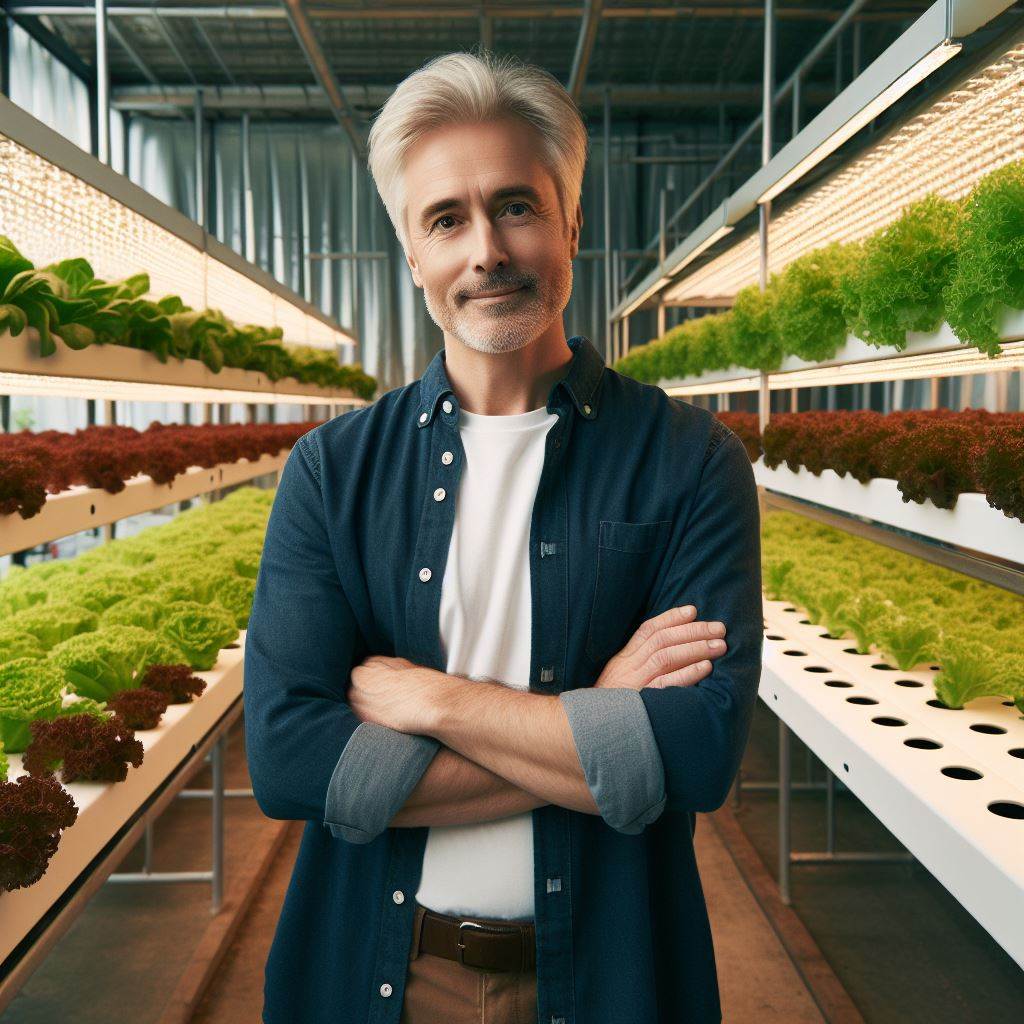Introduction
Hydroponics, a soilless farming method, is gaining relevance in urban farming. It offers numerous benefits for city dwellers.
In the dynamic tapestry of city life, the concept of hydroponics weaves a narrative of resilience and adaptability.
Beyond the constraints of traditional agriculture, hydroponics propels us into an era where limited space becomes an opportunity, and vertical landscapes evolve into verdant cascades of growth.
Hydroponics, at its essence, is a soilless farming technique that leverages nutrient-rich water solutions to nurture plants.
The cityscape, typically dominated by concrete and steel, undergoes a green revolution as hydroponic systems take root on rooftops, balconies, and even within the walls of urban buildings.
This innovative approach not only challenges the limitations imposed by urban environments but also addresses critical issues of food security, resource efficiency, and environmental sustainability.
Imagine a skyline dotted not only with architectural marvels but also with thriving gardens suspended in the air, a testament to the harmonious coexistence of urban living and nature.
Hydroponics transcends traditional boundaries, offering a tangible solution to the increasing demand for fresh, locally sourced produce in the heart of bustling cities.
As we delve deeper into the intricacies of hydroponics, we uncover its potential to redefine the urban farming landscape.
From controlled environments that optimize growth conditions to the meticulous monitoring of nutrient levels, hydroponics stands as a beacon of technological integration in agriculture.
Join us on this exploration of the city’s green evolution, where hydroponics emerges as a catalyst for change, fostering sustainable practices, community engagement, and a renewed connection between urban dwellers and the food they consume.
Together, let’s uncover the untapped potential that lies within the synergy of technology, nature, and the cityscape. Welcome to the future of urban farming – welcome to the world of hydroponics.
History of Hydroponics
Hydroponics, also known as soilless farming, has a rich history dating back centuries and has seen significant advancements in urban agriculture.
In this section, we will explore the origins, early development, and major milestones of hydroponics.
Origins and Early Development of Hydroponics
- The Hanging Gardens of Babylon: One of the early examples of hydroponics can be traced back to the ancient wonder known as the Hanging Gardens of Babylon.
- Aztec Floating Gardens: The Aztecs practiced a form of hydroponics called chinampas, where they created floating gardens on lakes and grew crops on rafts made from intertwined reeds.
- Botany Experiments by Jan Van Helmont: In the 17th century, Jan Van Helmont conducted experiments on plant growth and discovered that water alone could sustain a plant’s growth.
- Work of Johann Baptist von Helmont: Johann Baptist von Helmont furthered the understanding of hydroponics in the 17th century by experimenting with different soil substitutes for plant growth.
Major Milestones in the Adoption of Hydroponics for Urban Agriculture
- Dr. William Frederick Gericke: In the 1920s, Dr. Gericke, a plant nutritionist, coined the term “hydroponics” and showcased the potential of soilless farming.
- WWII and Space Research: Hydroponics gained popularity during World War II and post-war years as a means to produce food in limited spaces and explore its potential for space travel.
- The Green Revolution: In the 1960s, hydroponics received increased attention due to its ability to produce high-yielding crops with efficient water usage, contributing to the Green Revolution.
- NASA’s Research on Hydroponics: NASA’s interest in hydroponics has led to extensive research and promoted technologies for growing food in space, enabling self-sustaining space missions.
- Commercialization of Hydroponics: Over the years, hydroponics has transitioned from experimental research to commercial ventures, with urban farms and vertical gardens emerging in cities worldwide.
- Development of Advanced Techniques: Advancements such as nutrient film technique (NFT), deep-water culture (DWC), and aeroponics have made hydroponics more efficient and accessible.
With the long history and continuous development, hydroponics has emerged as a solution for growing food in urban settings, addressing space and resource constraints.
Transform Your Agribusiness
Unlock your farm's potential with expert advice tailored to your needs. Get actionable steps that drive real results.
Get StartedIts adoption in urban agriculture continues to shape how we produce food sustainably in the modern world.
In the next section, we will delve into the benefits and challenges of hydroponics in urban farming, exploring how this innovative approach holds promise for the future of agriculture.
Read: Urban Livestock: Raising Chickens & More
Types of hydroponic systems
In the world of urban farming, hydroponics has become a popular method for growing plants without soil.
There are various types of hydroponic systems, each with its own advantages and disadvantages.
Let’s delve into these systems and explore some successful examples in urban areas.
Description and explanation of various types of hydroponic systems commonly used in urban farming
Deep water culture (DWC)
Plants are suspended in nutrient-rich water with air stones providing oxygen to the roots.
Pros
Easy to set up and low-cost, suitable for growing leafy greens and herbs.
Cons
Susceptible to power outages, requires monitoring of pH and nutrient levels.
Successful examples
The Plant Chicago, situated in a former meatpacking plant, uses DWC to grow lettuce and herbs efficiently.
Nutrient film technique (NFT)
Nutrient-filled water flows continuously over the roots, with excess water returning to the reservoir.
Pros
Efficient use of water and nutrients, ideal for rapid growth of smaller plants.
Cons
Prone to clogging, vulnerable to power interruptions, not suitable for large plants.
Successful examples
Gotham Greens operates NFT systems on rooftops in New York City, supplying fresh produce to local markets.
Aeroponics
Plant roots are exposed to air and sprayed with a nutrient mist at regular intervals.
Pros
Maximizes oxygen uptake, reduces water usage, allows for faster growth.
Cons
Requires advanced equipment, prone to clogging, higher initial cost.
Successful examples
Edel Greens in Berlin utilizes aeroponic systems to grow nutrient-dense microgreens in a vertically stacked setup.
Drip system
Nutrient solution is delivered to plant roots through a network of tubes and drippers.
Pros
Versatile and widely used, easy to automate, suitable for different crop sizes.
Cons
Potential for clogs, need for regular maintenance, can be inefficient with water usage.
Successful examples
The Plantagon in Sweden combines a vertical greenhouse and drip irrigation, producing various crops sustainably.
Wick system
Nutrient solution is drawn into a growing medium through a wick, providing moisture to the roots.
Pros
Simple design, low maintenance, suitable for small-scale and beginner hydroponic growers.
Showcase Your Farming Business
Publish your professional farming services profile on our blog for a one-time fee of $200 and reach a dedicated audience of farmers and agribusiness owners.
Publish Your ProfileCons
Limited to growing smaller plants, slower growth rates, the wick can dry out quickly.
Successful examples
Growing Underground in London employs the wick system in their underground hydroponic farm, focusing on microgreens and herbs.
Each hydroponic system offers unique benefits and challenges, making it crucial for urban farmers to choose the one that best suits their needs.
Factors such as space availability, crop types, and budget should be considered when deciding on a hydroponic system.
It’s worth noting that many successful hydroponic systems in urban areas have integrated multiple systems to maximize efficiency and yields.
For instance, vertical farms often utilize a combination of NFT, aeroponics, and drip systems to optimize space utilization and crop production.
When implementing any hydroponic system, attention should be given to the quality of the nutrient solution, lighting, and environmental control.
Proper maintenance, regular monitoring, and adjustments are essential to ensure plant health and productivity.
To sum up, hydroponics offers an innovative and sustainable solution for urban farming.
With various hydroponic systems available, urban farmers have the flexibility to choose the system that best fits their requirements.
By embracing soilless farming, cities can enjoy abundant fresh produce and reduce their dependence on traditional agriculture.
Read: Balcony Farms: Grow Food in Small Spaces
Advantages of hydroponics in urban environments
In urban environments, hydroponics offers several advantages that make it an efficient and sustainable farming method.
Utilization of limited space efficiently
Hydroponics allows farmers to grow crops vertically, maximizing the use of limited space available in cities.
By utilizing vertical farming techniques, hydroponic systems can produce higher yields compared to traditional soil-based farming methods.
Conservation of water resources
Hydroponics requires significantly less water compared to conventional agriculture.
The closed-loop system in hydroponics allows for the recycling and reusing of water, reducing water waste.
This efficient water management is particularly crucial in urban areas where water scarcity may be an issue.
Enhanced control over nutrient delivery
Hydroponics provides precise control over the nutrient composition and delivery to plants.
Farmers can customize the nutrient solutions according to the specific needs of each crop, resulting in healthier plants and better yields.
This level of control also minimizes the use of chemical fertilizers, making hydroponics more environmentally friendly.
Reduction of pests and diseases
Hydroponic systems present fewer opportunities for pests and diseases to thrive compared to traditional farming methods.
Since hydroponics eliminates the use of soil, it reduces the risk of soil-borne pests and diseases.
This reduction in pest and disease pressure minimizes the need for chemical pesticides, making hydroponic produce safer for consumption.
Opportunities for year-round cultivation
Hydroponics enables year-round cultivation, ensuring a constant and reliable food supply in urban areas.
By providing a controlled environment, hydroponic systems can simulate and maintain optimal growing conditions regardless of external seasonal variations.
This eliminates the limitations imposed by traditional farming methods, such as crop cycles and weather-dependent yields.
Overall, hydroponics offers numerous advantages for urban farming.
Its efficient use of limited space, conservation of water resources, enhanced nutrient control, reduction of pests and diseases, and year-round cultivation opportunities make it a sustainable solution for food production in cities.
Read: Sustainable Fertilizers: A Carbon Fix

Challenges and Considerations in Urban Hydroponics
Hydroponics in the city is a promising solution for sustainable food production, but it comes with its fair share of challenges and considerations that need to be carefully addressed.
Initial setup costs and maintenance expenses
- Setting up a hydroponic system in an urban environment can be costly due to the need for infrastructure and specialized equipment.
- Ongoing maintenance expenses include the purchase of nutrient solutions, replacement of equipment, and regular monitoring.
- However, the long-term benefits and potential profitability of urban hydroponics can outweigh these initial costs.
Energy requirements for artificial lighting and climate control
- Indoor hydroponic systems require artificial lighting to provide sufficient light energy for plant growth.
- The use of high-intensity lamps and LED lights can significantly increase energy consumption.
- Controlling the temperature, humidity, and ventilation within the growing area also adds to the energy demands.
- Efficient energy management strategies, such as using energy-saving technologies and renewable energy sources, are crucial for sustainable urban hydroponics.
Proper waste management and recycling
- Hydroponics generates wastewater and organic waste that need to be properly managed to minimize environmental impact.
- Recycling and treating nutrient solutions and managing spent substrates are essential for resource conservation.
- Implementing efficient filtration systems and implementing wastewater reuse practices contribute to sustainable urban farming.
Lack of awareness and technical knowledge among urban farmers
- Many urban farmers may lack the necessary awareness and technical knowledge to successfully implement hydroponic systems.
- Understanding the principles of hydroponics, nutrient management, and plant physiology is crucial for maximizing yields and minimizing risks.
- Training programs, workshops, and educational resources should be provided to bridge the gap and empower urban farmers with the required skills.
In general, urban hydroponics offers immense potential for sustainable food production in cities.
However, it is crucial to address the challenges and considerations that come with this innovative farming method.
Moreover, by addressing initial setup costs, managing energy requirements, implementing proper waste management practices, and providing education and technical support, urban hydroponics can thrive and contribute to the development of environmentally friendly urban agriculture.
Read: Permaculture Zones: Effective Planning
Success stories and case studies
In this section, we will explore success stories and case studies of hydroponic farms in various cities, discussing their positive impacts on their respective communities.
Highlighting successful hydroponic farms in different cities
Rooftop Revolution in New York City
- A hydroponic farm on the rooftop of a Brooklyn building is successfully growing fresh vegetables.
- Local restaurants and residents benefit from the farm’s produce, reducing the need for imported food.
- The farm provides employment opportunities and education on sustainable farming practices.
Urban Oasis in Tokyo
- A hydroponic farm in Tokyo has transformed a vacant lot into a thriving oasis of green.
- The farm supplies restaurants and supermarkets with high-quality, pesticide-free vegetables.
- Local volunteers maintain the farm, fostering a sense of community and shared responsibility.
Singapore’s Sky Farms
- Singapore has embraced hydroponics to overcome its limited agricultural land.
- High-tech vertical farms produce a significant amount of food for the city-state.
- These farms employ advanced automation and resource-efficient techniques, reducing food waste and water consumption.
Revolutionizing Food Production in Detroit
- Hydroponics has played a vital role in revitalizing Detroit’s abandoned buildings and vacant lots.
- Urban farmers are growing fresh produce, improving access to nutritious food in underserved neighborhoods.
- The farms have created employment opportunities and empowered communities to take control of their food sources.
The Farm-to-Table Movement in Vancouver
- Hydroponic farms in Vancouver are supplying local restaurants with a sustainable source of fresh herbs and greens.
- Restaurants have reduced their carbon footprint by sourcing produce locally instead of importing.
- Customers enjoy the taste and nutritional benefits of locally grown food while supporting the community.
The Positive Impacts of Hydroponic Farms
These success stories and case studies highlight the many positive impacts of hydroponic farms on their communities:
- Increase in Access to Fresh Produce: Hydroponic farms bring fresh and nutritious food to areas where traditional farming is challenging.
- Reduced Environmental Impact: Soilless farming techniques require less water, land, and pesticides, contributing to a greener environment.
- Empowerment of Local Communities: Urban farms create employment opportunities, educate individuals on sustainable practices, and foster community engagement.
- Expansion of Local Economies: Hydroponic farms support local businesses by supplying fresh produce, keeping revenue within the community.
- Promotion of Food Security: These farms help reduce dependence on imports, ensuring a reliable food supply even during disruptions.
- Improvement in Public Health: Access to fresh, locally grown produce promotes healthier eating habits and reduces the risk of foodborne diseases.
Hydroponic farms have demonstrated their ability to revolutionize food production in urban areas, promoting sustainability, and enhancing communities’ well-being.
These success stories inspire others to embrace soilless farming and contribute to a more resilient and food-secure future.
Potential for scalable hydroponic systems in the city
Innovative approaches to scaling up urban hydroponics
Hydroponics, the soilless farming method, holds immense potential for scaling up in urban areas.
Showcase Your Farming Business
Publish your professional farming services profile on our blog for a one-time fee of $200 and reach a dedicated audience of farmers and agribusiness owners.
Publish Your ProfileScaling up urban hydroponics requires innovative approaches that address the unique challenges of city environments.
Collaboration between researchers, farmers, and urban planners
Collaboration between researchers, farmers, and urban planners is crucial for the successful implementation of scalable hydroponic systems.
Researchers can provide valuable insights into optimizing hydroponic techniques for urban settings, while farmers can offer practical experience and knowledge.
Urban planners play a vital role in integrating hydroponics into the urban landscape and ensuring proper infrastructure and zoning.
The role of hydroponics in creating sustainable food systems
Hydroponics has the potential to revolutionize food production in cities by creating sustainable and resilient food systems.
By eliminating the need for arable land and reducing water consumption, hydroponics can address the challenges of limited space and resource scarcity.
Scalable hydroponic systems can be designed to fit various urban spaces, from rooftops and balconies to abandoned buildings and vertical farms.
The flexibility of hydroponics allows for innovative solutions that adapt to the specific constraints of different cities.
Vertical farming, for example, maximizes space utilization by growing plants in stacked layers, creating a vertical agriculture system.
Hydroponics can also be integrated into urban infrastructure, such as green walls or underground tunnels, utilizing unused spaces efficiently.
Scalable hydroponic systems offer numerous benefits beyond increased food production.
The reduced need for transportation in urban areas decreases carbon emissions and food miles, contributing to a greener and more sustainable city.
Furthermore, hydroponics can help mitigate food insecurity by providing fresh produce year-round, regardless of climate or season.
By bringing food production closer to consumers, hydroponics fosters a stronger connection between people and their food sources.
Local hydroponic farms can support community engagement, education, and initiatives promoting healthy eating habits.
Scaling up hydroponics in cities presents economic opportunities as well.
Urban farming ventures can create jobs, stimulate local economies, and enhance food security by reducing reliance on imports.
Investments in hydroponic infrastructure can attract entrepreneurship and innovation, contributing to a thriving urban agricultural sector.
However, realizing the full potential of scalable hydroponic systems requires overcoming various challenges.
Access to funding, technological advancements, and knowledge dissemination are critical factors for successful implementation.
Government support and policies that incentivize urban hydroponics can play a crucial role in overcoming these barriers.
In a nutshell, scaling up hydroponic systems in cities is an innovative approach to address sustainability, food security, and economic development.
Collaboration between researchers, farmers, and urban planners is essential to unlocking the potential of hydroponics in urban environments.
Moreover, by embracing hydroponics, cities can create resilient, sustainable, and localized food systems for a healthier and greener future.
Conclusion
Hydroponics offers numerous advantages for urban farming, including efficient use of space, water, and nutrients.
However, there are also challenges such as the initial setup cost and the need for technical knowledge.
Despite these challenges, the potential for hydroponics to contribute to food security and sustainable urban development is significant.
By eliminating the need for soil, hydroponics allows crops to be grown in any urban setting, even rooftops and vertical farms.
With proper planning and implementation, hydroponics can provide fresh and nutritious produce to city dwellers all year round.
Additionally, hydroponics conserves water resources and reduces the environmental impact associated with traditional agriculture.
Its controlled environment minimizes the use of pesticides and herbicides, resulting in healthier and safer food for consumers.
Moreover, urban hydroponics can bring economic opportunities to local communities by creating jobs and supporting local food systems.
Given the increasing population and urbanization, hydroponics has the potential to revolutionize urban farming and address food insecurity.
It offers a sustainable solution that allows cities to become more self-reliant and resilient in terms of food production.
Therefore, it is crucial for governments, businesses, and communities to recognize and support the potential of hydroponics in the city.
Moreover, by embracing this innovative farming method, we can build a resilient and sustainable food system that nourishes urban populations for generations to come.




